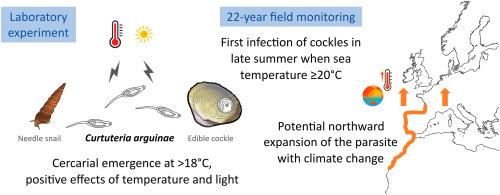温度的小幅升高可迅速扩大海洋吸虫的纬度范围和致病性
IF 2.6
3区 地球科学
Q1 MARINE & FRESHWATER BIOLOGY
引用次数: 0
摘要
本文研究了海洋吸虫库特利亚(cututeria arguinae)的物候和传播动力学,该寄生虫最近被发现的生活史涉及牡蛎(ostralegus Haematopus)、针螺(Bittium reticulatum)和食用蛤(Cerastoderma edule)。为了评估温度和光照对子宫颈羽化的影响,在光照和黑暗条件下,将受感染的网纹白蛉暴露在15°C至27°C的温度下。在温暖和光照条件下,尾蚴的出现达到高峰,表现出强烈的温度依赖性,并且在较小程度上表现出光依赖性。≥21℃时羽化率显著,羽化率中位数为12 ~ 47只。第−1天,光的积极影响在较高温度下被抵消。研究人员还分析了法国Arcachon湾22年的数据集,以确定贝首次感染的时间与海洋和空气温度以及贝壳大小的关系。在夏末,平均海水温度为20.8°C,首次观察到蛤贝感染,一旦达到热阈值,就会出现尾蚴传播。这种对热的依赖解释了这种寄生虫目前在南方的分布。随着气候变暖,它的活动范围很可能沿着大西洋东北海岸向北扩展,在所有宿主已经存在的地区。其向北延伸也可能支持其扩张。在寄生虫已经存在的地区,气温上升可能会增加子宫颈产量和感染强度,增加对中间宿主的致病作用,并对生态系统功能和贝渔业构成越来越大的威胁。本文章由计算机程序翻译,如有差异,请以英文原文为准。

A small increase in temperature could rapidly expand the latitudinal range and pathogenicity of the marine trematode parasite Curtuteria arguinae
The phenology and transmission dynamics of the marine trematode Curtuteria arguinae were investigated, a parasite whose recently elucidated life cycle involves oystercatchers (Haematopus ostralegus), needle snails (Bittium reticulatum), and edible cockles (Cerastoderma edule). To assess the influence of temperature and light on cercarial emergence, infected B. reticulatum were exposed to temperatures ranging from 15 °C to 27 °C under both light and dark conditions. Cercarial emergence peaked under warm and illuminated conditions, showing strong temperature dependence, and, to a lesser extent, light dependence. Emergence occurred significantly at temperatures ≥21 °C, with median emergence rates of 12–47 cercariae.day−1, and the positive influence of light was overruled at higher temperatures. A 22-year dataset from Arcachon Bay (France) was also analyzed to determine the timing of first infections in cockles relative to sea and air temperatures, as well as cockle shell size, across ten cohorts. First infections of cockles were consistently observed in late summer, with a mean sea temperature of 20.8 °C, placing cercarial transmission once a thermal threshold is reached. This thermal dependency explains the parasite's current southern distribution. With climate warming, its range is likely to expand northward along the northeastern Atlantic coast, in areas where all hosts are already present. Expansion may also be supported by the northward extension of B. reticulatum. In areas where the parasite is already established, rising temperatures may enhance cercarial output and infection intensity, increasing pathogenic effects on both intermediate hosts and posing a growing threat to ecosystem functioning and cockle fisheries.
求助全文
通过发布文献求助,成功后即可免费获取论文全文。
去求助
来源期刊
CiteScore
5.60
自引率
7.10%
发文量
374
审稿时长
9 months
期刊介绍:
Estuarine, Coastal and Shelf Science is an international multidisciplinary journal devoted to the analysis of saline water phenomena ranging from the outer edge of the continental shelf to the upper limits of the tidal zone. The journal provides a unique forum, unifying the multidisciplinary approaches to the study of the oceanography of estuaries, coastal zones, and continental shelf seas. It features original research papers, review papers and short communications treating such disciplines as zoology, botany, geology, sedimentology, physical oceanography.

 求助内容:
求助内容: 应助结果提醒方式:
应助结果提醒方式:


